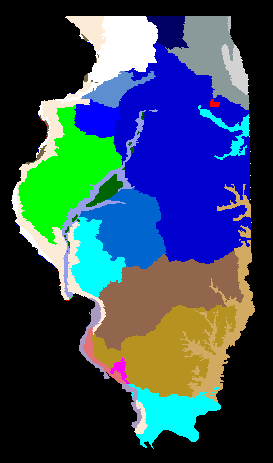Introduction:
Prairies in Illinois
 |
| Natural Divisions of Illinois Midewin NTP in Red Grand Prarie Division in Royal Blue |
The Natural Divisions classification system recognizes six prairie community classes (Schwegman, et al, 1973):
1. Prairie. Also called ”black soil prairie.” This type is the most widespread in Illinois. It has deep, fine-textured soils formed in silt and clay, ranging from dry to wet. The kinds of plants vary based on the amount of moisture.
Midewin NTP
a. Dry Prairie. Dominant plants are little bluestem (Schizachyrium scoparium) and side-oats grama grass (Bouteloua curtipendula), and where moister, Indian grass (Sorghastrum nutans), pale coneflower (Echinacea pallida), and lead plant (Amorpha canescens). Grasses are usually less than a meter tall.
b. Mesic Prairie. Dominant plants are big bluestem (Andropogon gerardii), indian grass, prairie dropseed (Sporobolus heterolepis), rattlesnake master (Eryngium yuccifolium), blazing star (Liatris pycnostachya), and compass plant (Silphium laciniatum). Some characteristic animals are the prairie vole (Microtus ochrogaster), prairie kingsnake (Lampropeltis calligaster calligaster), and the Grasshopper Sparrow (Ammodramus savannarum) and, when moister, Bobolink (Dolichonyx oryzovirus).
c. Wet Prairie. Dominant plants are blue-joint grass (Calamagrostis canadensis), sedges (Carex sp.), and prairie cord grass (Spartina pectinata). These prairies contain surface water in winter and spring, and are used by a variety of migrating waterfowl and wading birds.
2. Sand Prairie. Soils are coarse-textured sands or sandy loam and range from dry to wet. Wet sand prairie is similar to wet prairie in the kinds of plants that are present. Little bluestem and prickly pear cactus (Opuntia compressa) occur on the drier sand prairies, whereas pale coneflower (Echinacea pallida), gray-headed coneflower (Ratibida pinnata), and compass plant (Silphium lancinatum) occur on more mesic sites.
3. Gravel Prairie. Soils are gravelly and rich in calcium and range from dry to mesic (moist, but not wet). Some characteristic plants are little bluestem and prairie dropseed.
4. Dolomite Prairie. This type is the most restricted in Illinois. It occurs where dolomite, a type of sedimentary rock, is less than 1.5 m from the ground surface. At Drummond Dolomite Prairie at Midewin, Dolomite pavement (exposed dolomite bedrock) supporting only lichens and mosses occurs. These soils are subject to seasonal variations in soil moisture because the bedrock impedes drainage, but the shallow soils have little water holding capacity. Common plants are little bluestem , side-oats grama, and hairy beard-tongue (Penstemom hirsutus). In moister areas, prairie dropseed, and leafy prairie clover (Dalea foliosum), blue-joint, and Ridell’s goldenrod (Solidago riddellii) are present.
5. Hill Prairie. Hill prairies typically occur on steep, south to southwest-facing slopes. The substrate is frequently loess (wind-blown silt and clay). Because of direct exposure to sunlight, these prairies are usually dry. Typical plants include little bluestem, side-oats grama, blue-eyed grass (Sisyrhinchium campestre), green milkweed (Asclepias viridiflora), and gray scurf-pea (Psoralidium tennuiflorum).
6. Shrub Prairie. The soils are sandy, commonly acid. Shrubs and prairie grasses dominate.
The different prairie types normally do not occur as discreet, sharply delineated communities on the landscape but merge into one another. The typical prairie landscape in Illinois is a level to gently rolling mosaic of grasses and forbs with occasional timber in groves or along streams. It is a complex and diverse ecosystem responding especially to subtle variations in soil moisture and texture.
Next | Back